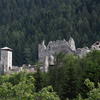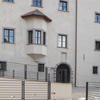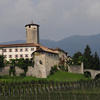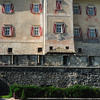From castle to castle by train 2017
Enjoy a special day on-board an exclusive train discovering some of the most famous castles and tastes of Val di Non and Val di Sole

Accompanied by expert tour guides, this adventure will unfold to be a fascinating trip into the history and art held within the Castles San Michele and Caldes in the Val di Sole, stretching to the private mansion ofCastel Valer and the majestic Thun Castle in the Val di Non.
In between visits the passengers will have the chance to enjoy a healthy breakfast offered by Melinda and Latte Trento, a banquet of typical products brought together by the consortium“Strada della Mela”, wines and bubbles hosted by the Cantina Rotari Mezzacorona estates, and to round up the tasting, an infusion of medicinal herbs to sip while enjoying the beautiful lights and hues of a sunset in the unique setting of an antique castle.
PROGRAMME
at 8.20: meeting place in Trento at the Railway station Trento-Malè
at 8.45: train's departure
at 10.35: arrival at the train station in Mezzana and continuation of the tour by coach
from 11.00: visit of the castles-
S. MICHELE CASTLE
The castle is located on a rocky outcrop and it dates back to the Lombard period even though the first written material regarding the castle is from 1191. Over the years, several noble families owned the castle and between the nineteenth and twentieth century, Bertha von Suttner, winner of the Nobel Peace Prize in 1905 was also a co-owner of the castle.
The castle’s tower, which is 25 meters high, is the best conserved and most characteristic feature of the entire castle. -
CALDES CASTLE
The Caldes Castle, located in the town of Caldes, was built during the 13th and 17th century and it is connected with many legends and a tragic love story. The castle’s architecture is a combination of Venetian, German and Lombard cultures which is typical of this area that was at the border of the Prince-Bishopric of Trento. This large 5 storey, 13th century tower house was built by the Cagnò family in 1464 and then given to the Thun family; during the 19th century it was bought by a local family and today it is owned by the Autonomous Province of Trento that restored the castle and turned into a prestigious venue for temporary exhibits and cultural events.
-
S. MICHELE CASTLE
-
-
VALER CASTLE
Castel Valer is situated near Tassullo in a panoramic position, encircled by hills, which are covered by orchards, and it excels for its faultless elegance.
Its tower is the higher of the province and it measures 40 metres. It has an octagonal plan and it was built partially in imported granite. This structure shines for its majesty and peculiarity among the other towers in Trentino.
The chapel of the castle is dedicated to Saint Valerio, and probably the name of the castle originates from the cult of this man, even if it is unlikely a roman derivation. The first evidence of Castel Valer dates back to 1211, when it was a property of the Counts Appiano and it was used as military guard post.
It was sold to the Coredo’s and to Sporo’s in 1368, who are still the owners.
The following series of castle walls, which have the aim to bound the perimeter of the structure, follow the octagonal shape of the ancient tower and they contain both buildings: the most ancient part, which dates back to XIV century and which is called Castel di sotto and the second part, which dates back to XVI century and which is called Castel di sopra.
The Chapel of Saint Valerio is situated in the northern part of the castle, between the main and the external curtain. It is entirely painted in fresco by the brothers Giovanni and Battista Baschenis, two travelling artists, who were natives of Bergamo. The frescoes have a good chromatic vividness and they represent Saint Valerio on the throne together with Saint Fabiano and Saint Sebastiano. THUN CASTLE
Emblem of the ancient glories of one of the most powerful and richest Trentino families, the Tonos, with its undisputed beauty and importance Castel Thun still dominates on all the other manors of the Val di Non. A reflection of the centuries-long domination of this noble family on the Valley, the castle – that stands on a hill not far from the village of Vigo di Ton - testifies times of both past glory and decay.
The name of the House of Tono, or Thun in its Germanized form, was first recorded in the 13th century and also gave its name to the castle. The family was destined to become the local and European leading seat in the history of the Trento Prince Bishopric: after acquiring the ancient Belvesino fortress, the Tonos started its renovation making it their luxury family manor.The vast expanse of the building testifies to the skilful architecture applied to exploit the surrounding mountainous territory for defensive purposes. The core of Castel Thun stands on top of a hill: it is an imposing palazzo with square plan, three turrets with Gothic cusp located sideways and a fourth turret at the corner. In the lower levels there are several walls, a result of the centuries old transformations of the castle from defensive fortress to lavish aristocratic residence; corner turrets, massive towers, double curtains and moats complete the complex. On the northern side, facing the wooden bridge - once a drawbridge – stands the peculiar Spanish Door, named in memory of the legendary journey to Spain taken by a young member of the Thun family; the door is protected by two turrets, so-called “malta” turrets, and is finely finished with ashlar-work.
Magnificence and refinement are the best words to describe the castle’s 150 rooms. Among them, the following stand out for their elegance: the Bishop’s Room (Stanza del Vescovo), entirely panelled in Swiss pine, and the Hearth Room (Stanza del Camino), with a most beautiful Renaissance fireplace. In the Room of the Dead (Stanza dei morti) walls are still blackened by the smoke of candles burnt during wakes.
19.15 - expected return in Trento
Source: www.iltreninodeicastelli.it
-
VALER CASTLE
Bookings: tel. 0463 423002
info@guidavacanze.it
www.iltreninodeicastelli.it






